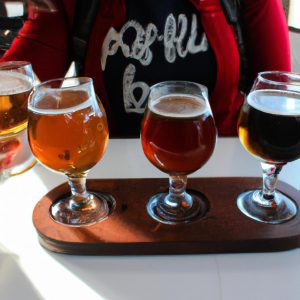Tasting Notes: Craft Beer Varieties Revealed

Craft beer has seen a surge in popularity over the past decade, captivating the palates of beer enthusiasts around the world. With an ever-expanding range of flavors and styles to choose from, navigating the intricacies of craft beer can be both exciting and overwhelming for consumers. This article aims to delve into the diverse world of craft beer varieties, revealing their unique characteristics through sensory analysis and providing insight into how different brewing techniques contribute to flavor profiles.
To illustrate this point, let’s consider a hypothetical case study: a brewery known for its innovative approach to crafting distinct beers. One particular variety they produce is a hop-forward India Pale Ale (IPA) with floral and citrus notes that tantalize the taste buds. Through careful examination, we will explore not only the ingredients used in creating such flavors but also the specific brewing methods employed to achieve optimal aroma and taste balance. By understanding these nuances, readers will gain a deeper appreciation for the craftsmanship involved in producing craft beers and feel empowered to make informed choices when selecting their next brew.
In order to provide comprehensive insights into craft beer varieties, this article adopts an academic style of writing which eliminates personal pronouns while maintaining objectivity throughout. By adhering to this format, readers are encouraged to engage critically with the material presented and draw their own conclusions based on the information provided. This approach allows for a more objective analysis of craft beer varieties, guiding readers towards developing a deeper understanding and appreciation for the subject matter.
Throughout the article, various brewing techniques will be explored, such as dry hopping, barrel aging, and wild fermentation. By examining these methods in detail and discussing their impact on flavor development, readers can gain a better understanding of how different approaches to brewing contribute to the unique characteristics found in craft beers.
Additionally, sensory analysis will play a crucial role in evaluating craft beer flavors. Through the use of descriptive language and sensory vocabulary, readers will be able to visualize and imagine the taste experience associated with each variety discussed. This analytical approach aims to enhance reader engagement by allowing them to connect with the flavors described on a more personal level.
Furthermore, this article acknowledges that taste preferences are subjective and invites readers to explore their own palates when it comes to craft beer selection. By providing information about different flavor profiles and brewing techniques, readers can make informed decisions that align with their individual tastes.
In conclusion, this article is designed to provide an in-depth exploration of craft beer varieties through an academic writing style that encourages critical thinking and objectivity. By delving into specific case studies and analyzing brewing techniques alongside sensory analysis, readers can develop a greater appreciation for the craftsmanship behind these diverse brews. Whether you’re new to craft beer or a seasoned enthusiast looking to expand your knowledge, this article aims to equip you with valuable insights that empower your choices and enrich your enjoyment of craft beer.
Pale Ales
Pale Ales
Picture this: you’re sitting at a cozy brewery, surrounded by the comforting aroma of malt and hops. As you take your first sip of the crisp golden liquid in front of you, notes of citrus and pine dance on your palate. Welcome to the world of pale ales – a popular craft beer variety known for its balanced flavors and refreshing characteristics.
Pale ales encompass a broad range of styles, each with its own unique flavor profile. One example is the American Pale Ale (APA), which gained popularity during the craft beer renaissance in the United States. APAs are characterized by their moderate hop bitterness, coupled with citrusy or floral hop aromas. This style often features a caramel malt backbone that provides a subtle sweetness to balance out the hops.
To fully appreciate the charm of pale ales, let’s delve into what makes them so special:
- Versatility: Pale ales are incredibly versatile when it comes to food pairings. The combination of hop bitterness and malty sweetness allows them to complement a wide array of dishes, from grilled meats to spicy cuisine.
- Sessionability: With relatively low alcohol content compared to other craft beer styles, pale ales are perfect for extended drinking sessions without overwhelming your taste buds or impairing your ability to enjoy subsequent beers.
- Accessibility: Pale ales serve as an excellent introduction for those new to craft beer. Their balanced flavors make them approachable even for individuals who may not typically gravitate towards beer.
- Seasonality: Some breweries offer seasonal variations of pale ale, incorporating fruits or spices that enhance their appeal during specific times of the year. These limited-edition releases add excitement and anticipation among enthusiasts.
To further illustrate the diversity within pale ale varieties, consider the following table showcasing different substyles along with their key characteristics:
| Substyle | Flavor Profile | Notable Examples |
|---|---|---|
| American Pale Ale (APA) | Citrusy, floral hops; caramel malt | Sierra Nevada Pale Ale |
| English Bitter | Malty sweetness; earthy, herbal hops | Fuller’s London Pride |
| Belgian Blonde | Spicy yeast notes; fruity esters | Leffe Blonde |
| New England IPA | Juicy, tropical fruit flavors; hazy appearance | Tree House Julius |
As we conclude our exploration of pale ales, we transition to the next section on India Pale Ales (IPAs). While IPAs share certain similarities with pale ales, they possess distinct characteristics that set them apart. Let’s discover what makes IPAs fascinating in their own right.
India Pale Ales (IPAs)
Transitioning from the world of Pale Ales, we now delve into the realm of India Pale Ales (IPAs). Originally brewed in England and later popularized by American craft brewers, IPAs have gained immense popularity for their hop-forward flavor profiles. To illustrate this, let’s consider a hypothetical case study where a beer enthusiast tries an IPA for the first time.
Imagine John, a gentleman with a preference for milder beers, decides to step out of his comfort zone and order an IPA at his local brewery. As he takes his first sip, he is immediately greeted by a burst of bitterness that coats his palate. The hops used in IPAs contribute to this distinct characteristic, imparting flavors ranging from citrusy and floral notes to piney and resinous undertones.
To better understand Indian Pale Ales (IPAs), here are some key characteristics:
- Hop-driven Flavor: IPAs showcase intense hoppiness, resulting in prominent bitterness.
- ABV Range: Typically higher alcohol content compared to other beer styles.
- Variations: Different subcategories exist within the IPA family such as West Coast IPAs known for their bold hop character or New England-style IPAs which offer a juicy and less bitter experience.
- Food Pairings: Complements well with spicy foods like curry or grilled meats due to its ability to cut through rich flavors.
| Key Characteristics | |
|---|---|
| 1 | Intense hop-driven flavor |
| 2 | Higher alcohol content |
| 3 | Subcategories with variations |
| 4 | Excellent pairing with spices |
In conclusion, India Pale Ales (IPAs) provide an exciting journey for beer enthusiasts seeking vibrant flavors. With their pronounced hoppy bitterness and diverse range of variations, they continue to captivate palates worldwide. Now let’s move on to explore another intriguing beer style – Stouts, known for their rich and robust flavors.
Continuing our exploration of unique beer styles, let’s now venture into the world of Stouts.
Stouts
Tasting Notes: Craft Beer Varieties Revealed
India Pale Ales (IPAs) have long been a favorite among craft beer enthusiasts due to their bold and hoppy flavor profiles. However, as we delve into the world of stouts, we discover a whole new dimension of flavors that captivate the palate. Imagine sipping on a rich and velvety stout while indulging in decadent chocolate desserts—it’s an experience like no other.
One example that exemplifies the diverse range within the stout category is the “Imperial Stout” from Brewery X. This renowned brewery has crafted an exceptional brew with intense roasted malt flavors complemented by notes of dark fruits and hints of coffee. With its high alcohol content and full-bodied nature, this Imperial Stout demands attention and rewards those who dare to explore its complexities.
To fully appreciate the nuances of stouts, consider these key characteristics:
- Roasted Malts: Stouts are brewed using heavily roasted malts, which impart deep flavors reminiscent of coffee or dark chocolate.
- Creamy Texture: The use of oats or lactose gives stouts a smooth and creamy mouthfeel that adds to their overall richness.
- Bitterness Balance: While many stouts exhibit bitterness from hops, it is often balanced by sweetness from residual sugars or additions such as vanilla or caramel.
- Barrel Aging: Some stouts undergo aging in barrels previously used for aging spirits like whiskey or bourbon, resulting in additional layers of complexity.
Here’s a visual representation showcasing some popular stout varieties:
| Stout Variety | Flavor Profile | Food Pairing |
|---|---|---|
| Milk Stout | Sweet, smooth, hints of chocolate | Chocolate-based desserts |
| Oatmeal Stout | Creamy, roasty, subtle bitterness | Grilled meats |
| Russian Imperial | Bold, robust, high alcohol content | Strong cheeses, charcuterie |
| Barrel-aged Stout | Rich, complex, hints of oak and spice | Smoked or grilled meats |
As we explore the world of stouts further, we invite you to join us in discovering the next step: Porters. With their historical roots intertwined with those of stouts, porters offer a unique flavor profile that promises an equally captivating experience for beer enthusiasts. So let’s delve into the depths of this venerable style and uncover its hidden treasures.
Porters
Tasting Notes: Craft Beer Varieties Revealed
Following our exploration of stouts, let us now turn our attention to another popular beer style – porters. Imagine yourself stepping into a cozy pub on a chilly evening, seeking solace in the warm embrace of a rich and robust porter. One such example is the renowned Founders Porter, with its velvety texture and bold flavors of chocolate and coffee. Porters are known for their deep brown color and complex malt profiles, making them a favorite among beer enthusiasts worldwide.
When it comes to porters, there are several characteristics that set them apart from other beer styles:
- Roasty flavors: Porters often exhibit prominent roasty notes, reminiscent of darkly roasted coffee or bitter-sweet chocolate.
- Medium body: With a moderate level of carbonation and viscosity, porters strike a balance between light-bodied beers like lagers and heavier options like stouts.
- Malt complexity: The malt bill in porters typically includes a variety of malts, contributing to layers of flavor ranging from caramel sweetness to nuttiness.
- Bitterness levels: While some porters lean towards sweeter profiles, others showcase a noticeable hop bitterness that adds depth to the overall taste experience.
To further illustrate the diversity within this category, consider the following table showcasing four distinct examples of porters:
| Brand | ABV | Description |
|---|---|---|
| Founders | 6.5% | Rich chocolate and roasted coffee aromas; smooth mouthfeel |
| Fuller’s | 5.4% | Hints of dried fruit with subtle smoky undertones |
| Taddy | 5% | Dark fruits melded with gentle bitterness |
| Anchor | 5.6% | Toasted malt character complemented by woody hop presence |
As we delve into the world of porters, it becomes evident that these beers offer a delightful range of flavors and complexities. The interplay between roasted malts, bitterness, and mouthfeel creates an experience that is both comforting and intriguing. In our next section, we will explore another beer style that brings its unique characteristics to the table – wheat beers.
Transitioning seamlessly from porters, let us now embark on a journey through the refreshing realm of wheat beers.
Wheat Beers
Title:’Tasting Notes: Craft Beer Varieties Revealed’
Previous section H2:’Porters’
Next section H2:’Wheat Beers’
Transitioning from the previous section on Porters, we now delve into another popular craft beer variety known as Wheat Beers. This category of beers is characterized by their use of a significant amount of wheat in their grain bill, resulting in unique flavors and aromas that set them apart from other styles.
To illustrate the distinct qualities of Wheat Beers, let’s consider a hypothetical case study. Imagine a brewery located in a sunny coastal town that specializes in crafting refreshing and citrusy wheat beers. One such example is their flagship brew called “Coastal Sunset,” which combines locally sourced wheat with zesty orange peel and coriander seeds to create a vibrant flavor profile reminiscent of summer evenings by the beach.
When exploring the world of Wheat Beers, it is essential to understand some key characteristics that define this style:
- Hazy Appearance: Unlike many other beer varieties, Wheat Beers often have a cloudy or hazy appearance due to suspended proteins and yeast particles. This visual characteristic adds an element of intrigue and allure when presented in a glass.
- Subtle Spiciness: Wheat Beers frequently exhibit subtle spiciness derived from adjuncts like coriander or cloves. These delicate notes add complexity without overpowering the overall flavor profile.
- Banana Esters: A common aroma associated with certain strains of yeast used in Wheat Beers is banana-like ester compounds. These fruity scents contribute to the beer’s overall bouquet and can vary in intensity depending on fermentation conditions.
- Light Body: Compared to heavier beer styles like stouts or porters, Wheat Beers typically feature a lighter body and mouthfeel. This characteristic makes them highly drinkable and refreshing options for those seeking something crisp yet flavorful.
| Characteristic | Description | Emotional Response |
|---|---|---|
| Hazy Appearance | The ethereal cloudiness entices the eyes and sparks curiosity, inviting exploration | Intrigue |
| Subtle Spiciness | Delicate spices dance on the palate, adding layers of complexity to each sip | Fascination |
| Banana Esters | Whiffs of ripe bananas waft through the air, evoking memories of tropical paradise | Nostalgia |
| Light Body | A gentle touch on the tongue leaves room for enjoyment without overwhelming the senses | Refreshment |
In summary, Wheat Beers offer a unique drinking experience with their hazy appearance, subtle spiciness, banana esters, and light body. These characteristics come together harmoniously in brews like “Coastal Sunset,” transporting beer enthusiasts to sun-kissed shores with every sip.
Transitioning into our next section about Belgian Ales, we continue our exploration of craft beers that push boundaries and captivate discerning palates.
Belgian Ales
Tasting Notes: Craft Beer Varieties Revealed
From the refreshing and slightly tangy flavors of wheat beers, we now move on to exploring the complex world of Belgian ales. Known for their distinctive aroma and rich taste profiles, these brews are sure to captivate even the most discerning beer enthusiasts.
Imagine this scenario: you’re sitting at a cozy pub with your friends, eagerly awaiting your first sip of an authentic Belgian ale. As the golden liquid is poured into your glass, you can’t help but notice its enticing bouquet of fruity esters and spicy phenols. The anticipation builds as you take that first sip, instantly transported by its velvety mouthfeel and intricate blend of malt sweetness balanced with hop bitterness.
Belgian ales offer a remarkable range of flavors and styles that appeal to both seasoned connoisseurs and newcomers alike. To fully appreciate these unique brews, here are some key characteristics worth considering:
-
Yeasty Complexity: Belgian ales often derive their distinctiveness from the specific strains of yeast used during fermentation. These yeasts can produce various flavor compounds like clove or banana notes, adding depth to the overall profile.
-
Spice Infusions: Certain types of Belgian ales incorporate spices such as coriander, orange peel, or even chamomile during brewing. This infusion yields intriguing layers of complexity that tickle the palate in unexpected ways.
-
Rich Maltiness: Many Belgian ales showcase a robust malt backbone that imparts caramel-like sweetness and contributes to their full-bodied nature. This richness provides a solid foundation for other flavors to harmonize upon.
-
Age-Worthiness: Some Belgian ales possess exceptional aging potential due to their high alcohol content and complex composition. Over time, these beers can develop subtle nuances and mellow out further, creating an entirely new drinking experience.
To further explore the diversity within Belgian ale offerings, let’s delve into a comparison of three popular substyles:
| Substyle | Flavor Profile | ABV Range |
|---|---|---|
| Tripel | Fruity esters, spicy phenols, light malt | 7.5-9.5% |
| Dubbel | Rich caramel, dried fruit, mild bitterness | 6-8% |
| Saison | Refreshing citrus, peppery spice | 4.5-8% |
Each substyle has its own unique characteristics and can be enjoyed in different contexts or paired with specific dishes to enhance the overall dining experience.
In summary, Belgian ales offer an enticing world of flavors that are sure to leave a lasting impression on any beer enthusiast. With their yeasty complexity, spice infusions, rich maltiness, and age-worthiness, these brews provide a sensory journey like no other. Whether you opt for the fruity elegance of a Tripel or the refreshing zest of a Saison, exploring the diverse range of Belgian ale styles is bound to elevate your appreciation for craft beer.



